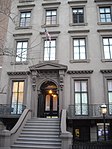The New York Studio School of Drawing, Painting and Sculpture at 8 West 8th Street, in Greenwich Village, Manhattan, New York City, New York State is an art school formed in 1963 by a group of students and their teacher, Mercedes Matter, all of whom had become disenchanted with the fragmented nature of art instruction inside traditional art programs and universities. Today it occupies the building that previously housed the Whitney Museum of American Art.
From its start, the Studio School was founded on the principle that drawing from life should form of the basis of artistic development. Furthermore, rather than attending a series of disjointed classes, students were encouraged to develop their artistic practice along lines similar to the "atelier" approach favored by European art schools.
Faculty has included painters Charles Cajori, Louis Finkelstein, Philip Guston, Rosemarie Beck, Alex Katz, Earl Kerkam, George McNeil, and Esteban Vicente; sculptors Peter Agostini, Sidney Geist, Ophrah Shemesh, Reuben Nakian, and George Spaventa. Nicolas Carone and Mercedes Matter focused on drawing instruction and Meyer Schapiro and Leo Steinberg taught art history. Former deans of the school have included the renowned composer Morton Feldman and artist/critic/curator Robert Storr. The present dean, since 1988, is the British-born painter Graham Nickson who instituted the two-week intensive Drawing Marathon, staged twice a year ahead of each semester and which is now fixture of the academic program.When founded, the school did not—by intention—offer formal degrees. However, today, students are able to obtain a Master of Fine Arts. The MFA program's first graduating class was in 2005.The School presents an Evening Lecture Series in the Fall and Spring semesters, generally twice a week, featuring an international roster of speakers including artists talking on their own work and critics and scholars covering a range of historic subjects. The School's exhibition program, in its committed gallery space, was described by critic Mario Naves in the New York Observer as "one of the city's most significant venues for contemporary art."In 2005, the school was among 406 New York City arts and social service institutions to receive part of a $20 million grant from the Carnegie Corporation, which was made possible through a donation by New York City mayor Michael Bloomberg.








